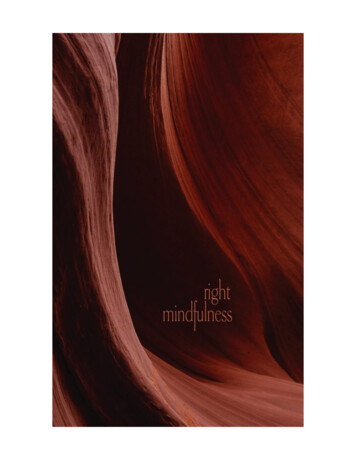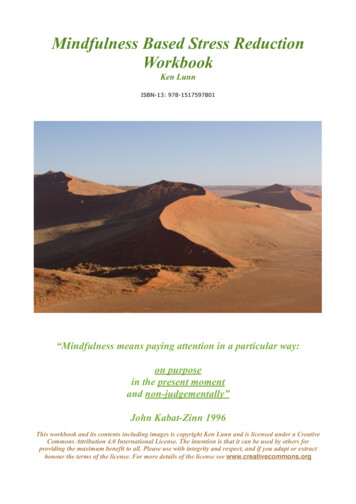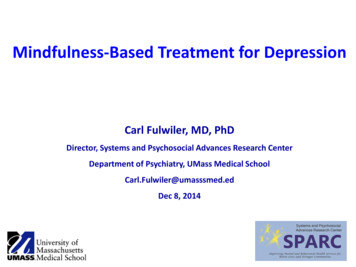
Transcription
2Right MindfulnessMEMORY & ARDENC YON THE BUDDHIST PATH H fi N I S S A R O B H I K K H U(GEOF F REY De GRAF F )for free distribution
3Inquiries may be addressed to:The AbbotMetta Forest MonasteryPO Box 1409Valley Center, CA 92082USACopyright h›nissaro Bhikkhu 2012This book may be copied or reprinted for free distributionwithout permission from the publisher.Otherwise all rights reserved.
4“Just as a royal frontier fortress has a gatekeeper—wise,experienced, intelligent—to keep out those he doesn’t knowand to let in those he does, for the protection of thosewithin, and to ward off those without; in the same way, adisciple of the noble ones is mindful, endowed withexcellent proficiency in mindfulness, remembering &recollecting what was done and said a long time ago. Withmindfulness as his gatekeeper, the disciple of the noble onesabandons what is unskillful, develops what is skillful,abandons what is blameworthy, develops what is blameless,and looks after himself with purity.” — AN 7:63
5ContentsAbbreviationsIntroductionPA R T O NEChapter 1: Mindfulness the GatekeeperChapter 2: The Lessons of FabricationChapter 3: Experience Is PurposefulChapter 4: The Burden of Bare AttentionPAR T TWOChapter 5: Mindfulness of ReadingChapter 6: The Structure of Breath MeditationChapter 7: Fleshing out the Four TetradsPA R T THR EEChapter 8: A Slice of MindfulnessChapter 9: A Structure for ArdencyChapter 10: WhyAppendix 1: The fin›p›nasati SuttaAppendix 2: The Mah› Satipa h›na SuttaAppendix 3: Jh›na & Right ConcentrationGlossary
ra Nik›yaCullavaggaDhammapadaDıgha Nik›yaItivuttakaMajjhima Nik›yaSaªyutta Nik›yaSutta nces to DN, Iti, and MN are to discourse (sutta). Thoseto Dhp are to verse. The reference to Cv is to chapter,section, and sub-section. References to other texts are tosection (saªyutta, nip›ta, or vagga) and discourse. Numberingfor AN and SN follows the Thai Edition of the Pali Canon.All translations from these texts are by the author, and arebased on the Royal Thai Edition of the Pali Canon (Bangkok:Mah›makut R›javidy›laya, 1982).
7IntroductionFor the past several decades, a growing flood of books, articles, and teachingshas advanced two theories about the practice of mindfulness (sati). The first isthat the Buddha employed the term mindfulness to mean bare attention: a stateof pure receptivity—non-reactive, non-judging, non-interfering—towardphysical and mental phenomena as they make contact at the six senses. Thesecond theory is that the cultivation of bare attention can, on its own, bringabout the goal of Buddhist practice: freedom from suffering and stress. In thepast few years, this flood of literature has reached the stage where even in nonBuddhist circles these theories have become the common, unquestionedinterpretation of what mindfulness is and how it’s best developed.The premise of this book is that these two theories are highly questionableand—for anyone hoping to realize the end of suffering—seriously misleading. Atbest, they present a small part of the path as the whole of the practice; at worst,they discredit many of the skills needed on the path and misrepresent what itactually means to taste awakening.The main aim of this book is to show that the practice of mindfulness is mostfruitful when informed by the Buddha’s own definition of right mindfulness andhis explanations of its role on the path. As he defined the term, right mindfulness(samm›-sati) is not bare attention. Instead, it’s a faculty of active memory, adeptat calling to mind and keeping in mind instructions and intentions that will beuseful on the path. Its role is to draw on right view and to work proactively insupervising the other factors of the path to give rise to right concentration, andin using right concentration as a basis for total release.The discussion here falls into three parts. Part One (Chapters One throughFour) explores the mental qualities that comprise right mindfulness, showinghow they relate both to other factors of the path and to the causes of sufferingand stress that the path is designed to abandon. Chapter One starts with ananalysis of the Buddha’s standard formula for the practice of right mindfulness,in which mindfulness is one of three qualities brought to the act of remainingfocused on a frame of reference, the other two qualities being ardency andalertness. Ardency is of particular importance, for it constitutes the proactiveelement in mindfulness practice.The chapter then shows how right mindfulness keeps in mind the threeaspects of right view: the proper framework for regarding experience (the fournoble truths); the motivation for adopting that framework; and the dutiesprescribed by the framework—duties that ardency is meant to follow. Thediscussion then focuses on the ways in which right mindfulness relates to twohighly proactive factors of the path: right effort and right concentration. Itsrelationship to these factors is so close that all three interpenetrate one another inbringing about release.Chapter Two deals with the ways in which right mindfulness is developedthrough a sensitivity to the workings of cause and effect—a sensitivity that canbe gained only by consciously manipulating the intentional bodily, verbal, andmental fabrications that shape experience.
8Chapter Three explains why conscious fabrication is a necessary part of thepath, exploring the implications of the fact that, in dependent co-arising,fabrications conditioned by ignorance precede and shape not only the act ofattention, but also contact at the senses. This means that these unskillfulfabrications have to be replaced by skillful ones, conditioned by knowledge interms of the four noble truths, if the path is to succeed in undercutting the causesof suffering. This fact determines the role of right mindfulness in turningattention into appropriate attention, and supervising the development of theskillful fabrications of the path.Chapter Four explains why the common modern view of mindfulness has tobe rejected because it doesn’t do justice to the dual role of fabrication: both as aprecondition for attention and sensory contact, and as a part of the path to theend of suffering and stress. This defect in the common view has practicalconsequences, in that it can provide only a limited range of strategies for puttingan end to stress when compared to the strategies provided in the discourses.Parts Two and Three take the lessons learned in Part One about the proactivenature of mindfulness practice and apply them to a reading of the two majorcanonical discourses explaining this practice.Part Two (Chapters Five through Seven) focuses on the fin›p›nasati Sutta(MN 118). Chapter Five explains how the skillful act of reading any of theBuddha’s teachings is, in and of itself, a part of mindfulness practice, equippingright mindfulness with knowledge in terms of the three aspects of right view.This chapter also discusses the Buddha’s own instructions on how to listen to(and, at present, to read) his teachings: penetrating the meaning of eachdiscourse on its own terms, and pondering its relationship to his otherdiscourses. These instructions guide the discussions in both Part Two and PartThree.Chapter Six focuses on the lessons to be learned from the structure of MN118, particularly concerning the way in which the sixteen proactive steps ofbreath meditation are related in practice to one another and to the practice ofestablishing mindfulness (satipa h›na). Two points here are of centralimportance. The first is that the sixteen steps fall into four tetrads (sets of four)corresponding to the four frames of reference used in the practice of establishingmindfulness: body, feelings, mind, and mental qualities in and of themselves. Thesecond point is that these tetrads are actually four aspects of a single practice—remaining focused on the breath—which means that any of the four frames ofreference can be developed while remaining focused on the first: the body in andof itself. This point has practical implications for all varieties of mindfulnesspractice.Chapter Seven draws lessons both from MN 118 and from other canonicaldiscourses to flesh out the details of how the sixteen steps of breath meditationcan most effectively be mastered as skills.Part Three (Chapters Eight through Ten) focuses on the Mah› Satipa h›naSutta (DN 22). Chapter Eight shows how DN 22, despite its considerable length,covers only a part of the satipa h›na formula—the various frames ofreference—while giving next to no guidance on how to apply ardency in thecontext of those frames.To fill in this blank, Chapter Nine—in addition to providing a detailedpractical analysis of the various exercises and categories listed in DN 22 for each
9frame of reference—draws on other discourses to flesh out the role of ardencywith regard to those exercises and categories. This chapter concludes with adiscussion of how the four frames of reference interact in practice, showing howthe latter three frames of reference can be developed while focusing on exercisesrelated to the first.Chapter Ten focuses on the parts of DN 22 that discuss the motivation fordeveloping right mindfulness: It’s a path going one way only (ek›yana magga) tothe goal.The book concludes with three appendices. Appendices One and Two,respectively, contain translations of the full texts of MN 118 and DN 22.Appendix Three examines one of the central tenets of the common modern viewof mindfulness: that jh›na (meditative absorption) is unnecessary for awakening.The importance of this tenet to the modern view would suggest that it should bediscussed in Part One. However, I found that the amount of space required totreat it adequately would have created too long a digression from the flow ofthat part of the book. That’s why I assigned it its own space as an appendix.Several features of the approach taken in this book deserve a few words ofexplanation. The first is that, wherever relevant, I have pointed out why thecommon modern interpretation of mindfulness gets in the way of benefittingfully from the practice the Buddha taught. I have not done this to stircontroversy. Rather, I have learned from experience that, given the wideranging misunderstandings on the subject, any discussion of what mindfulness ismust include a discussion of what it isn’t. Otherwise, views shaped by thecommon interpretation will act as a distorting lens, blurring our vision of whatthe Buddha actually taught and our understanding of how to put it into practice.Early Buddhists adopted a similar approach when organizing the first twonik›yas, or groups of discourses, in the P›li Canon. They opened both nik›yaswith discourses on teachings the Buddha rejected (see DN 1, DN 2, MN 1, andMN 2), before explaining the teachings he endorsed. This approach served toclear the air so that the main points of the teaching could be more readilydiscerned. That’s why I have adopted it here.To give an accurate presentation of the common modern view, I quotedpassages from the writings of those who endorse it, particularly in Chapter Fourand Appendix Three. However, I have not identified the authors of thesequotations, for two reasons. First is that monks are instructed not to disparageothers when teaching the Dhamma (AN 5:159). In practice, this means notidentifying, in a public talk or public writings, the names of people who one feelsare misinterpreting what the Dhamma has to say. Second, my aim in quotingthese passages is to focus not on individuals but on the general features andunderlying misconceptions of the common view. I realize that leaving one’ssources unnamed is not in line with modern practices, but I can state honestlythat I have tried to find passages that give the clearest and most responsibleexpression of the common view so as to highlight its salient features. I hope thatyou, the reader, will understand why I have handled these quotations in thisway.Some readers will find the discussion in Chapters Two through Four tootechnical for their tastes. For this reason, I have gathered the main points ofthose chapters at the beginning of Chapter Five, so that if you want, you can
10skip from Chapter One to Chapter Five, and from there straight into thediscussions in Parts Two and Three.Two further points need to be explained with regard to the discussions inthose parts of the book. The first concerns the range of materials from which Ihave drawn to flesh out the areas of mindfulness practice where MN 118 and DN22 give only implicit guidance or none at all. To ensure that the context fromwhich I have drawn these added teachings is as close as possible to the context inwhich MN 118 and DN 22 were recorded, I have taken as my primary source theparts of the Sutta Pi aka—the Collection of Discourses—most generallyconsidered to contain the oldest discourses in the Canon: the Dıgha Nik›ya,Majjhima Nik›ya, Saªyutta Nik›ya, and Aºguttara Nik›ya, along with theoldest books in the Khuddaka Nik›ya: the Dhammapada, Ud›na, Itivuttaka,Sutta Nip›ta, Therag›th›, and Therıg›th›. Where relevant, I have also taken afew passages from the Vinaya Pi aka, the Collection on Discipline, as these seemto come from the oldest strata of the Canon as well.I have touched only rarely on the Abhidhamma Pi aka, and on the vastcommentarial literature that has grown up around the topic of mindfulness bothin the Visuddhimagga (Path of Purity) and in the commentaries and subcommentaries on the relevant sections of the Canon. The discourses appear topredate the Abhidhamma by a century or two, and the commentaries by manycenturies more. Both the Abhidhamma and the commentaries use aninterpretative framework that differs markedly from the discourses’. So Ithought it would be best to look directly at what the discourses have to say onthis topic, with a minimum of filtering through later lenses. Anyone interested instudying how the Abhidhamma and commentaries later developed the teachingson mindfulness in the discourses is welcome to take the discussion here as a baseline for comparison.The second question that may arise with regard to the discussions in PartsTwo and Three is: Why do these texts require so much explanation? The answeris twofold. First, there is no way they could give complete coverage to the topicof right mindfulness. As the Buddha noted in MN 12, even if people were toquestion him on the topic of satipa h›na for 100 years, he could respondwithout repeating himself and they would never come to the end of his answers.The topic is that large. The second answer is that none of the discourses wereever meant to stand on their own. Each is embedded in a canon of textsmemorized by a living community of practitioners who would use them asmemory aids, both for teachers and for students. This means that each discoursehad to be long enough to convey the most important points but short enough tobe easily memorized. To get the most out of these memory aids, you have totake them in context—a context provided both by the collection of discourses asa whole and by the living tradition of the monastic community, in whichmeditation is learned as part of a teacher-apprentice relationship.Over the centuries, the lessons taught in the context of this apprenticeship indifferent communities have come to diverge from one another, sometimes quitewidely. To sort out which of these lessons are authoritative, we have to checkthem against the memory aids provided by the Canon. As the Buddha stated inDN 16, “Whatever Dhamma & Vinaya I have pointed out & formulated for youwill be your Teacher when I am gone.” That’s why the primary emphasis in thisbook is to discover what can be learned about right mindfulness from the
11context provided by the discourses, which contain the oldest extant records ofthe Dhamma. Whichever teachings in the living traditions are in line with thatcontext can be taken as authoritative; whichever are not should be rejected.However, always keep in mind that the context provided by the discourses,while authoritative, was never meant to be complete. It has to be augmented byliving traditions that are in harmony with it.A note on translation: In some of my previous writings I have translatedsatipa h›na as frame of reference; in others, as establishing of mindfulness. In thisbook I have adopted the latter translation, as it gives a better sense ofsatipa h›na as process, and I have used frame of reference to denote the topicsthat are kept in mind—body in and of itself, feelings in and of themselves, mindin and of itself, and mental qualities in and of themselves—as part of the processof establishing mindfulness.Many people have read this book in manuscript and provided helpfulsuggestions for improvement. In addition to the monks here at the monastery,these people include: Ven. Varadhammo Bhikkhu, Michael Barber, MatthewGrad, Addie Onsanit, Nathaniel Osgood, Narciso Polanco, Dale Schultz, MaryTalbot, Josephine Wolf, and Jane Yudelman. Ruby Grad kindly provided theindex. I am grateful to all these people for their assistance. Any errors thatremain in the book are, of course, my own responsibility.I hope that this book is helpful as aid and encouragement in your practice ofright mindfulness for the sake of total release. h›nissaro Bhikkhu(Geoffrey DeGraff)METTA FOREST MONASTERYJULY, 2012
12PART ONECHAPTER ONEMindfulness the GatekeeperThe Buddha adopted the term sati from the languages of his culture. It’srelated to the Sanskrit term smriti, which means remembrance or the act ofcalling to mind. However, there is no record of his having defined the term perse. Instead, the texts depict him as observing that there are two types of satiwhen viewed from the perspective of a person trying to put an end to suffering:right and wrong (MN 117; MN 126; AN 10:108). The texts also show him definingthe faculty of sati (sat’indrıya), which is equivalent to right sati:“And which is the faculty of sati? There is the case where a disciple of thenoble ones has sati, is endowed with excellent proficiency in sati,remembering & recollecting what was done and said a long time ago. Heremains focused on the body in & of itself—ardent, alert, & having sati—subduing greed & distress with reference to the world. He remainsfocused on feelings in & of themselves the mind in & of itself mentalqualities in & of themselves—ardent, alert, & having sati—subduing greed& distress with reference to the world. This is called the faculty of sati.” —SN 48:10This definition of right sati falls into two parts. In the first sentence, theBuddha is obviously retaining the meaning of its Sanskrit cognate—remembrance—showing how sati, when developed to the point of being afaculty, or dominant factor in the mind, is able to remember words and actionsfar into the past.The second part of the definition is identical with the definition of right sati inthe noble eightfold path, and is often called the establishing of sati (sati upa h›na [establishing, setting near] satipa h›na). This part of the definition setsout the task that sati is meant to keep in mind, along with the other mentalfactors that have to be developed, and the concerns that need to be subdued, tohelp keep sati firmly established on its task.In the practice of the path, sati and satipa h›na are mutually reinforcing. Onthe one hand, as the satipa h›na formula states, sati is one of the factors broughtto bear on the task of remaining focused as a part of satipa h›na. On the other,SN 48:11 notes that the practice of satipa h›na gives rise to strengthened sati.“And which is the faculty of sati? Whatever sati one obtains from the fourestablishings of sati: That is the faculty of sati.” — SN 48:11So, just as physical strength grows by being used in exercise, sati isstrengthened by being applied to the task of the four establishings of sati. Thishas practical consequences that we will discuss further below.
13The central task of satipa h›na is to remain focused on any one of four topicsas a frame of reference. The phrase, “remaining focused on” is nowhere definedin the Canon, but the P›li term (anupassan› anu [follow] passan› [seeing]) iscommonly used for two types of meditative practice: keeping watch over aparticular topic in the midst of other experiences, and looking for a particularquality in experiences as they arise.Both types of anupassan› are relevant in the practice of establishing sati. Anexample of the first comes in the standard satipa h›na formula. Remainingfocused on the body in and of itself, for example, means keeping track of thebody or a particular aspect of the body as a frame of reference in the midst of allyour sensory experiences. Even when another topic looms large in yourawareness, you try to keep track of where the body is in the midst of thatawareness, or of how that other topic and the body interact. In this way, thebody remains your frame of reference regardless of whatever else may arise.The same principle applies when remaining focused on feelings, mind, or mentalqualities in and of themselves.As for the second type of anupassan›—looking for a particular quality inexperiences as they arise—an example would be the practice of looking forinconstancy (anicca) in all phenomena. This, as we will see in Chapter Two, is oneof the steps by which sati is established through breath meditation.The four topics to remain focused on are body, feelings, mind, and mentalqualities. “Body” means the physical body; “feelings” covers feeling tones ofpleasure, pain, and neither pleasure nor pain; and “mind” covers states of mind.The phrase “mental qualities” (dhammas) covers a wider range of phenomena. Itsprimary meaning in this context covers mental events or mental actions, but italso covers any physical or mental experience viewed as an event. All of thesemeanings play a role in how right sati makes use of this frame of reference.There is some overlap between the content of “mind” and “mental qualities” asframes of reference, but as we will see in Chapters Six through Nine, theirdifference lies primarily in their respective functions. “Mind” is concernedprimarily with how the mind relates to the object of its focus; “mental qualities”are concerned with the qualities and thought-categories involved in the processof fending off any defilements or distractions that surround that focus orthreaten to interfere with it.The duty of sati is to remember to remain focused on any one of these topicsin and of itself. The P›li passage expresses this idea literally by saying, “body inthe body,” “feelings in feelings,” etc., with the locative case—a grammatical caseindicating location, often translated as “in”—also meaning “with reference to.” Inother words, each of these topics is viewed solely with reference to itself, on itsown terms, without subsuming it under a larger frame of reference, such as theworld outside. Each topic is thus a frame of reference in and of itself.Sati is one of three mental factors that should accompany the activity ofremaining focused in this way. The other two are alertness and ardency.The Canon defines alertness (sampajañña) as knowing both events in the mindand activities of the body as they are happening:“And how is a monk alert? There is the case where feelings are known tothe monk as they arise, known as become established, known as theysubside. Thoughts are known to him as they arise, known as they become
14established, known as they subside. Perceptions are known to him as theyarise, known as they become established, known as they subside. This ishow a monk is alert.” — SN 47:35“And how is a monk alert? When going forward & returning, he makeshimself alert; when looking toward & looking away when bending &extending his limbs when carrying his outer cloak, his upper robe, & hisbowl when eating, drinking, chewing, & savoring when urinating &defecating when walking, standing, sitting, falling asleep, waking up,talking, & remaining silent, he makes himself alert. This is how a monk isalert.” — SN 36:7This means that for sati to be properly established, it must not onlyremember far into the past, but also be coupled with a clear awareness of what’sgoing on in the present.Ardency (›tappa) is the desire to avoid what is unbeneficial.Ven. Mah›Kassapa: “And how is one ardent? There is the case where amonk, (thinking,) ‘Unarisen evil, unskillful qualities arising in me wouldlead to what is unbeneficial,’ arouses ardency. (Thinking,) ‘Arisen evil,unskillful qualities not being abandoned in me ’ ‘Unarisen skillfulqualities not arising in me ’ ‘Arisen skillful qualities ceasing in mewould lead to what is unbeneficial,’ he arouses ardency. This is how one isardent.” — SN 16:2The discourses often pair ardency with compunction (ottappa), fear of theconsequences of doing evil, perhaps because the words are so similar in meaningand—in P›li—in sound. (Here I am using compunction in its American sense, as atwinge of scrupulous conscience prior to doing wrong.) Working together, thesetwo qualities find expression in the determined abandoning of evil, unskillfulqualities. Without them, the goal would be impossible to attain.“A person without ardency, without compunction, is incapable of selfawakening, incapable of unbinding, incapable of attaining theunsurpassed safety from bondage. A person ardent & compunctious iscapable of self-awakening, capable of unbinding, capable of attaining theunsurpassed safety from bondage.” — Iti 34“If, while he is walking, there arises in a monk a thought of sensuality, athought of ill will, or a thought of harmfulness, and he does not quicklyabandon, dispel, demolish, or wipe that thought out of existence, then amonk walking with such a lack of ardency & compunction is calledcontinually & continuously lethargic & low in his persistence. [Similarly ifhe is standing, sitting, or lying down.]“But if, while he is walking, there arises in a monk a thought of sensuality,a thought of ill will, or a thought of harmfulness, and he quicklyabandons, dispels, demolishes, & wipes that thought out of existence, thena monk walking with such ardency & compunction is called continually &
15continuously resolute, one with persistence aroused. [Similarly if he isstanding, sitting, or lying down.]” — Iti 110Ardency is thus closely connected with right effort. In fact, it’s synonymouswith the desire explicit in the definition of right effort, and motivated by thediscernment of what’s skillful and unskillful—the element of right view implicitin that definition.“And what is right effort? There is the case where a monk generatesdesire, endeavors, activates persistence, upholds & exerts his intent for thesake of the non-arising of evil, unskillful qualities that have not yetarisen for the sake of the abandoning of evil, unskillful qualities thathave arisen for the sake of the arising of skillful qualities that have notyet arisen (and) for the maintenance, non-confusion, increase, plenitude,development, & culmination of skillful qualities that have arisen: This,monks, is called right effort.” — SN 45:8It’s worth noting here the centrality of desire in right effort. As AN 10:58observes, all phenomena are rooted in desire. This observation applies to skillfulas well as to unskillful phenomena. Without skillful desire, it would be impossibleto develop the path (SN 51:15). This means that the path is not a truth availableto passive observation. It’s a truth of the will: something that can become trueonly if you want it to happen. By applying the desire of right effort, the elementof skillful purpose, to the act of remaining focused, ardency enables sati to beestablished as right sati.Taken together, these mental factors of sati, alertness, and ardency indicatethat right sati, as a factor in the path to the end of suffering and stress, bringsmemories from the past to bear on a clear alertness of events and actions in thepresent with the purpose of abandoning unskillful qualities and developingskillful ones both in the present and on into the future. In this way, alertness andardency ensure that right sati points not only in one direction, to the past, but toall three directions of time at once: past, present, and future.When, in the nineteenth century, T. W. Rhys Davids encountered the wordsati while translating DN 22 into English, he tried to find an English term thatwould convey this meaning of memory applied to purposeful activity in thepresent. Concluding that English didn’t have an adequate equivalent, he madeup his own: mindfulness. This, of course, wasn’t a total invention. In fact, RhysDavids’ choice was apparently inspired by the phrasing of the Anglican prayer tobe ever mindful of the needs of others—i.e., to always keep their needs in mind.Rhys Davids simply turned the adjective into a noun. Although the termmindfulness has its origins in a Christian context, and although its meaning hasironically become so distorted over the past century, its original meaning servesso well in conveying the Buddhist sense of memory applied to the present that Iwill continue to use it to render sati for the remainder of this book.A. RIGHT VIEW, RIGHT MINDFULNESS, RIGHT EFFORTThe role played by mindfulness in applying memory of the past to presentactivities—for the sake of present and future results—is best illustrated by a
16passage in MN 117, in which the Buddha presents the first seven factors of thenoble eightfold path as requisites for right concentration, the final factor in thepath. With each of the first five factors, the three factors of right view, rightmindfulness, and right effort work together to abandon the wrong version ofthe factor and to develop the right version as an aid in noble right concentration.For example, with the factor of right resolve:“Right view is the forerunner. And how is right view the fo
The main aim of this book is to show that the practice of mindfulness is most fruitful when informed by the Buddha’s own definition of right mindfulness and his explanations of its role on the path. As he defined the term, right mindfulness (samm›-sati) is not bare a










